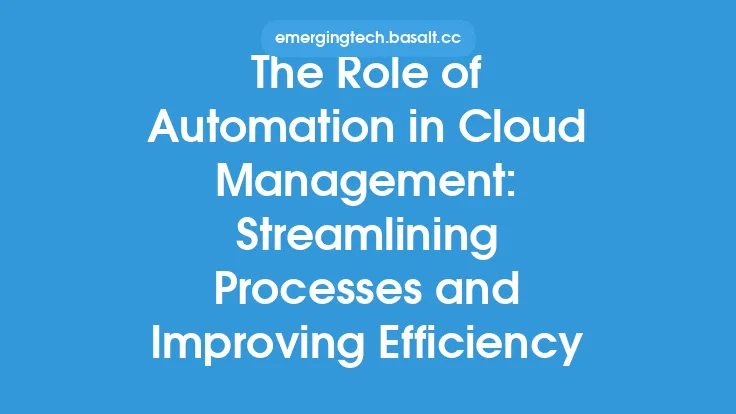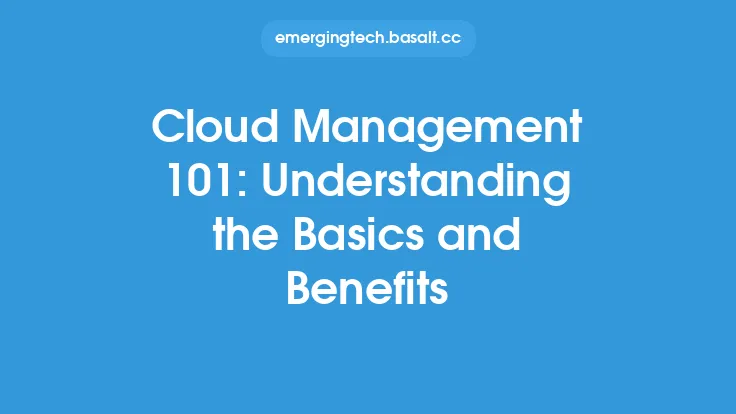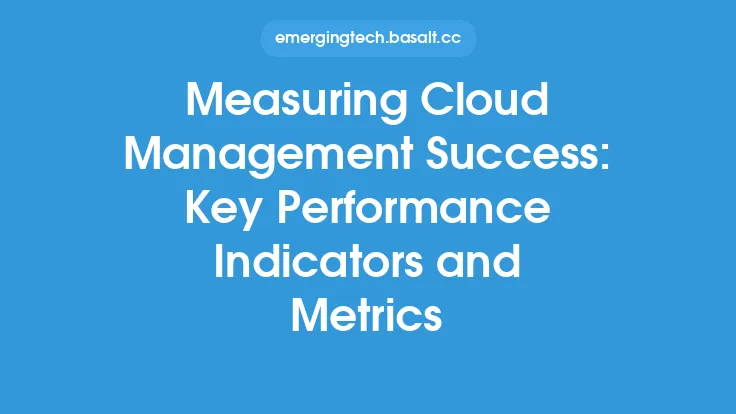The cloud has revolutionized the way organizations operate, providing unparalleled scalability, flexibility, and cost savings. However, as cloud adoption continues to grow, managing cloud resources effectively has become a major challenge. Cloud management and orchestration have emerged as crucial components in unlocking the full potential of cloud computing. In this article, we will delve into the world of cloud management and orchestration, exploring their importance, benefits, and key considerations.
Introduction to Cloud Management and Orchestration
Cloud management refers to the process of managing and monitoring cloud-based resources, including infrastructure, applications, and data. It involves a set of activities, such as provisioning, configuring, and optimizing cloud resources to ensure they are running efficiently and effectively. Cloud orchestration, on the other hand, is the process of automating and coordinating the provisioning and management of cloud resources. It involves creating a workflow that automates the deployment, scaling, and termination of cloud resources, ensuring that they are properly configured and optimized.
Benefits of Cloud Management and Orchestration
The benefits of cloud management and orchestration are numerous. Some of the most significant advantages include:
- Improved efficiency: Cloud management and orchestration automate many manual tasks, freeing up IT staff to focus on more strategic activities.
- Increased agility: Cloud management and orchestration enable organizations to quickly deploy and scale cloud resources, responding to changing business needs.
- Enhanced scalability: Cloud management and orchestration allow organizations to easily scale up or down to meet changing demand, without the need for manual intervention.
- Better cost management: Cloud management and orchestration provide real-time visibility into cloud usage and costs, enabling organizations to optimize their cloud spend.
- Improved security: Cloud management and orchestration provide a centralized platform for managing cloud security, ensuring that cloud resources are properly configured and secured.
Key Components of Cloud Management and Orchestration
Cloud management and orchestration involve several key components, including:
- Cloud infrastructure management: This involves managing the underlying cloud infrastructure, including compute, storage, and networking resources.
- Cloud application management: This involves managing cloud-based applications, including deployment, scaling, and optimization.
- Cloud data management: This involves managing cloud-based data, including storage, backup, and recovery.
- Cloud security management: This involves managing cloud security, including identity and access management, threat detection, and incident response.
- Cloud cost management: This involves managing cloud costs, including usage tracking, cost optimization, and budgeting.
Cloud Management and Orchestration Tools
There are many cloud management and orchestration tools available, including:
- Cloud management platforms (CMPs): These are comprehensive platforms that provide a centralized interface for managing cloud resources.
- Cloud orchestration tools: These are specialized tools that automate the provisioning and management of cloud resources.
- Cloud monitoring tools: These are tools that provide real-time visibility into cloud usage and performance.
- Cloud security tools: These are tools that provide cloud security management capabilities, including threat detection and incident response.
Best Practices for Cloud Management and Orchestration
To get the most out of cloud management and orchestration, organizations should follow best practices, including:
- Define clear cloud governance policies: This involves establishing clear policies and procedures for cloud usage and management.
- Implement automation: This involves automating as many cloud management tasks as possible, using cloud orchestration tools and scripts.
- Monitor and optimize cloud usage: This involves continuously monitoring cloud usage and optimizing cloud resources to ensure they are running efficiently and effectively.
- Ensure cloud security: This involves implementing robust cloud security measures, including identity and access management, threat detection, and incident response.
- Provide training and support: This involves providing IT staff with the training and support they need to effectively manage and orchestrate cloud resources.
Challenges and Limitations of Cloud Management and Orchestration
While cloud management and orchestration offer many benefits, there are also challenges and limitations to consider, including:
- Complexity: Cloud management and orchestration can be complex, requiring specialized skills and knowledge.
- Cost: Cloud management and orchestration tools and services can be expensive, especially for large-scale deployments.
- Security: Cloud management and orchestration introduce new security risks, including the risk of unauthorized access and data breaches.
- Vendor lock-in: Cloud management and orchestration tools and services can be proprietary, making it difficult to switch vendors or migrate to a different cloud platform.
Future of Cloud Management and Orchestration
The future of cloud management and orchestration is exciting, with new technologies and innovations emerging all the time. Some of the trends and developments to watch include:
- Artificial intelligence (AI) and machine learning (ML): These technologies are being used to automate and optimize cloud management tasks, including predictive analytics and anomaly detection.
- Containerization and serverless computing: These technologies are changing the way cloud resources are deployed and managed, with a focus on greater efficiency and scalability.
- Hybrid and multi-cloud deployments: These deployments are becoming increasingly common, requiring cloud management and orchestration tools and services that can span multiple cloud platforms.
- Edge computing: This involves deploying cloud resources at the edge of the network, closer to users and devices, requiring new cloud management and orchestration approaches.





